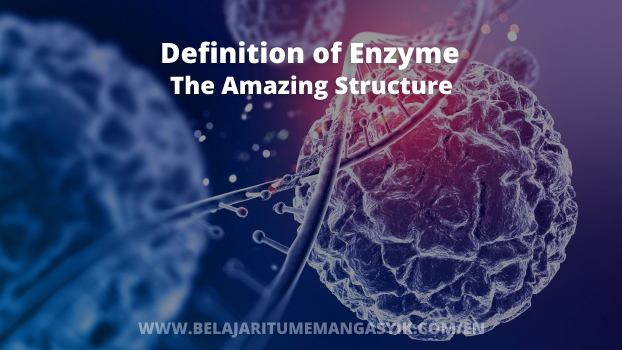Definition of Enzyme in the human body, food substances are broken down to produce energy in the form of ATP. This reaction is one of several chemical reactions that occur within living organisms.
Similarly, in plant bodies, a chemical reaction called photosynthesis also occurs. Thus, all chemical reactions that occur within living organisms are called metabolism.
The chemical reactions in metabolism occur very quickly. Enzymes are very important components in these reactions.
Definition of Enzyme
Enzymes are biomolecules that function as catalysts in chemical reactions. In this case, a catalyst is a substance that accelerates the reaction process without being consumed.
If this substance is not present, it can inhibit the activity that occurs in the body’s organs. In addition, enzymes are called bio-catalysts that play a role in accelerating biological reactions without changing the chemical structure.
The substrate is the initial molecule of the reaction, and the enzyme changes the molecule into different molecules, which are called the product. In general, all biological processes require enzymes for rapid continuation.
According to Kuhne (1878), the term enzyme comes from the Greek words “in” and “zyme” meaning something inside yeast. Based on studies, enzymes are a type of protein that consists of large molecules.
Enzymes have a part of the protein that is not heat-resistant, called the apoenzyme, while the non-protein part is the active part and is given a prosthetic group, usually a metal such as iron, copper, zinc, or an organic compound containing a metal.
Enzyme Structure
Enzymes consist of two components, the pro (apoenzyme) part and the non-protein part (prosthetic group). The apoenzyme is formed from protein and can easily change. This change can occur depending on pH and temperature.
Meanwhile, the prosthetic group can be said to be inactive groups. This substance contains various metal elements, such as magnesium, sodium, iron, and manganese.
However, there are also organic substances in the prosthetic group that are not proteins. For example, Vitamin B.
Enzymes in Cells
A living cell can be compared to a chemical factory that depends on energy and follows various chemical rules. Meanwhile, a chemical reaction that enables life is also called metabolism.
There are continuous reactions that occur in every cell, making metabolism a remarkable reaction. The metabolic pathways must be regulated carefully so that the cell can function and develop properly.
The cell can regulate which metabolic pathway runs and how fast by producing the appropriate catalysts called enzymes in the appropriate amount and at the required time.
Almost all chemical reactions are very slow without catalysts, and enzymes are more specific and stronger catalysts than metal ions or other inorganic compounds that can be absorbed by plants and soil.
So, enzymes generally increase the reaction rate by a factor of between 18 to 1020. Compared to human-made catalysts, enzymes are usually 10K to 10c times more effective.
Classification of Enzyme
Here is the classification of enzymes that you need to know.
Hydrolases Hydrolases are enzymes that can break down a substance with the help of water. Hydrolases themselves are further divided into several parts based on their substrates, including:
Carbohydrases Carbohydrases are enzymes that release carbohydrate groups. This group is further divided according to the carbohydrate that is broken down, such as:
Amylase, which is an enzyme that breaks down amylum (a polysaccharide) into maltose, a disaccharide. Maltase, which is an enzyme that processes maltose into glucose.
Sucrase, which is an enzyme that converts sucrose (sugar cane) into glucose and fructose. Lactase is an enzyme that can convert lactose into glucose and galactose.
Cellulase, which is an enzyme that processes cellulose (a polysaccharide) into cellobiose (a disaccharide). Pectinase, which is an enzyme that breaks down pectin into pectic acid.
Esterases Esterases are enzymes that break down ester groups. Examples include:
Lipase, which is an enzyme that breaks down fat into glycerol and fatty acids. Phosphatase, which is an enzyme that processes an ester until phosphoric acid is released.
Proteinase or protease Proteinase or protease are enzymes that break down protein groups. Examples include:
Peptidase, which is an enzyme that processes peptides into amino acids. Gelatinase, which is an enzyme that breaks down gelatin. Renin is an enzyme that breaks down casein from milk in Definition of Enzyme.
